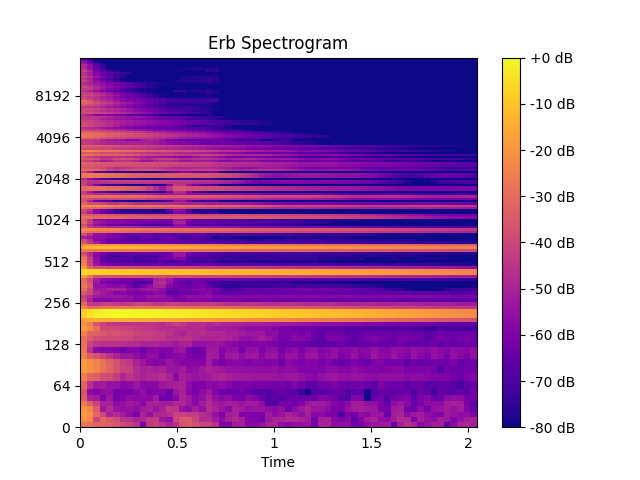audioflux.erb_spectrogram
- audioflux.erb_spectrogram(X, num=128, radix2_exp=12, samplate=32000, low_fre=None, high_fre=None, window_type=WindowType.HANN, slide_length=None, style_type=SpectralFilterBankStyleType.SLANEY, normal_type=SpectralFilterBankNormalType.NONE, data_type=SpectralDataType.POWER)
Erb-scale spectrogram.
Note
We recommend using the
BFTclass, you can use it more flexibly and efficiently.- Parameters
- X: np.ndarray [shape=(…, n)]
audio time series.
- num: int
Number of erb frequency bins to generate, starting at low_fre.
- radix2_exp: int
fft_length=2**radix2_exp.- samplate: int
Sampling rate of the incoming audio.
- low_fre: float
Lowest frequency.
- high_fre: float or None
Highest frequency. Default is 16000 (samplate / 2).
- window_type: WindowType
Window type for each frame.
See:
type.WindowType- slide_length: int or None
Window sliding length.
If slide_length is None, then
slide_length = fft_length / 4- style_type: SpectralFilterBankStyleType
Spectral filter bank style type. It determines the bank type of window.
- normal_type: SpectralFilterBankNormalType
Spectral filter normal type. It determines the type of normalization.
- data_type: SpectralDataType
Spectrogram data type.
It cat be set to mag or power. If you needs db type, you can set power type and then call the power_to_db method.
- Returns
- out: np.ndarray [shape=(…, fre, time)]
The matrix of ERB
- fre_band_arr: np:ndarray [shape=(fre,)]
The array of frequency bands
Examples
Read 220Hz audio data
>>> import audioflux as af >>> audio_path = af.utils.sample_path('220') >>> audio_arr, sr = af.read(audio_path)
Extract spectrogram of dB
>>> low_fre = 0 >>> spec_arr, fre_band_arr = af.erb_spectrogram(audio_arr, samplate=sr, low_fre=low_fre) >>> spec_dB_arr = af.utils.power_to_db(spec_arr)
Show spectrogram plot
>>> import matplotlib.pyplot as plt >>> from audioflux.display import fill_spec >>> import numpy as np >>> >>> # calculate x/y-coords >>> audio_len = audio_arr.shape[-1] >>> x_coords = np.linspace(0, audio_len/sr, spec_arr.shape[-1] + 1) >>> y_coords = np.insert(fre_band_arr, 0, low_fre) >>> >>> fig, ax = plt.subplots() >>> img = fill_spec(spec_dB_arr, axes=ax, >>> x_coords=x_coords, >>> y_coords=y_coords, >>> x_axis='time', y_axis='log', >>> title='Erb Spectrogram') >>> fig.colorbar(img, ax=ax, format="%+2.0f dB")
